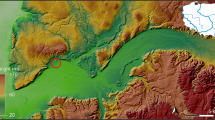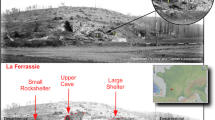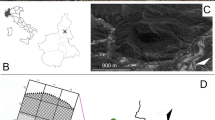Abstract
Recent years have seen increasing interest in the study of Oldowan technological variability, and the observed inter-assemblage diversity has been attributed to a number of causes, including raw material availability, different hominin species, and cultural and diachronic variation. This paper explores technological variability through the study of Naiyena Engol 2, an Oldowan site dated at c.1.8–1.7 Ma and located in the Nachukui Formation of West Turkana, Kenya. Site formation processes, stratigraphic and taphonomic aspects of Naiyena Engol 2, are reported and are followed by a discussion of the lithic assemblage, focusing on flaking techniques and battering activities. Our results show important diversity of flaking techniques within the same assemblage, suggesting that lithic variability is not only an inter-site phenomenon but also may be found within single Oldowan sites. Additionally, the overall low flake productivity of Naiyena Engol 2 is in sharp contrast with patterns observed in other West Turkana assemblages such as Lokalalei 2, thus also supporting the existence of significant inter-assemblage variability during the Oldowan.
Résumé
Au cours des dernières années, l’intérêt pour les études de la variabilité technologique de l’Oldowayen s’est accru. La diversité inter-assemblage, maintes fois observée, est attribuée à différentes causes telles la disponibilité des matières premières, la diversité hominienne, ou encore les variations culturelles ou diachroniques. Cet article explore la variabilité technologique à travers l’étude du site Oldowayen de Naiyena Engol 2, qui appartient à la Formation de Nachukui et est daté entre 1.8 et 1.7 millions d’années. La stratigraphie, les principaux aspects taphonomiques et de formation du site et l’ensemble du matériel archéologique sont présentés, suivis par une discussion sur l’ensemble lithique, axée sur les techniques de taille et autres activités de percussion. Nos résultats montrent une importante diversité dans les techniques de taille, suggérant que la variabilité lithique n’est. pas seulement un phénomène inter-sites, mais peut aussi être mise en évidence dans un seul et même ensemble. De plus, la faible production d’éclats à Naiyena Engol contraste fortement avec celle observée dans d’autres sites–dont le site plus ancien de Lokalalei 2C–suggérant aussi une forte variabilité inter-assemblage au cours de l’Oldowayen.
















Similar content being viewed by others
References
Adams, J., Delgado, S., Dubreuil, L., Hamon, C., Plisson, H., & Risch, R. (2009). Functional analysis of macro-lithic artefacts: A focus on working surfaces. In L. J. Costa, L. Eigeland, & F. Sternke (Eds.), Non-flint raw material use in prehistory: Old prejudices and new directions. Proceedings of the XVème Congress of the U.I.S.P.P. (pp. 43–66). Oxford: BAR International Series 1939.
Bordes, F. (1961). Typologie du Paléolithique ancien et moyen. Paris: CNRS Editions.
Brown, F. H., & Feibel, C. S. (1991). Stratigraphy, depositional environments, and paleogeography of the Koobi Fora Formation. In J. M. Harris (Ed.), Koobi Fora Research Project, The fossil ungulates: Geology, fossil artiodactyls, and palaeoenvironments (Vol. 3, pp. 1–30). Oxford: Clarendon Press.
Brown, F. H., & McDougall, I. (2011). Geochronology of the Turkana depression of northern Kenya and southern Ethiopia. Evolutionary Anthropology, 20(6), 217–227.
Brugal, J.-P., & Roche, H. (2018). Paleoecology and paleoenvironment of early Quaternary faunal assemblages from the Nachukui Formation in Kenya: Insights from the West Turkana Archaeological Project. In S. Reynolds & R. Bobe (Eds.), African paleoecology and human evolution. Cambridge: Cambridge University Press.
Brugal, J.-P., Roche, H., & Kibunjia, M. (2003). Faunes et paléoenvironnements des principaux sites archéologiques plio-pleistocènes de la formation de Nachukui (Ouest Turkana, Kenya). Comptes Rendus Palevol, 2(8), 675–684.
Crabtree, D. E. (1972). An introduction to flintworking. Pocatello: Idaho State University Museum.
de la Torre, I. (2011). The Early Stone Age lithic assemblages of Gadeb (Ethiopia) and the Developed Oldowan/Early Acheulean in East Africa. Journal of Human Evolution, 60, 768–812.
de la Torre, I., & Mora, R. (2005a). Unmodified lithic material at Olduvai Bed I: Manuports or ecofacts? Journal of Archaeological Science, 32, 273–285.
de la Torre, I., & Mora, R. (2005b). Technological strategies in the Lower Pleistocene at Olduvai Beds I & II. Liège: University of Liège Press. ERAUL 112.
de la Torre, I., & Mora, R. (2014). The transition to the Acheulean in East Africa: An assessment of paradigms and evidence from Olduvai Gorge (Tanzania). Journal of Archaeological Method and Theory, 21, 781–823.
de la Torre, I., Mora, R., Domínguez-Rodrigo, M., Luque, L., & Alcalá, L. (2003). The Oldowan industry of Peninj and its bearing on the reconstruction of the technological skills of Lower Pleistocene hominids. Journal of Human Evolution, 44, 203–224.
Delagnes, A., & Roche, H. (2005). Late Pliocene hominid knapping skills: The case of Lokalalei 2C, West Turkana, Kenya. Journal of Human Evolution, 48, 435–472.
Delagnes, A., Lenoble, A., Harmand, S., Brugal, J.-P., Prat, S., Roche, H., & Tiercelin, J.-J. (2006). Interpreting pachyderm single carcass sites in the African Early Pleistocene record: A multidisciplinary approach on the site of Nadung’a 4 (Kenya). Journal of Anthropological Archaeology, 25(2), 448–465.
Feibel, C. (2011). A geological history of the Turkana Basin. Evolutionary Anthropology, 20(6), 206–216.
Feibel, C., Brown, F. H., & McDougall, I. (1989). Stratigraphic context of fossil hominids from the Omo group deposits: Northern Turkana Basin, Kenya and Ethiopia. American Journal of Physical Anthropology, 78, 595–622.
Goren-Inbar, N., Sharon, G., Melamed, Y., & Kislev, M. E. (2002). Nuts, nut cracking, and pitted stones at Gesher Benot Ya’aqov, Israel. PNAS, 99, 2455–2460.
Harmand, S. (2005). Matières premières lithiques et comportements techno-économiques des homininés Plio-Pléistocènes du Turkana Occidental, Kenya. PhD dissertation, Université Paris X Nanterre.
Harmand, S. (2009a). Variability in raw material selectivity and techno-economic behaviors in the Early Oldowan: Evidence from the Late Pliocene sites of Lokalalei, West Turkana, Kenya. In E. Hovers & D. R. Braun (Eds.), Interdisciplinary approach to the Oldowan. Vertebrate paleobiology and paleoanthropology book series (pp. 85–97). London: Springer.
Harmand, S. (2009b). Raw material and economic behaviours at Oldowan and Acheulean in the West Turkana region, Kenya. In B. Adams & B. Blades (Eds.), Lithic materials and Paleolithic societies (pp. 3–14). Oxford: Blackwell Publishing.
Harmand, S., Lewis, J. E., Feibel, C. S., Lepre, C. J., Prat, S., Lenoble, A., Boës, X., Quinn, R. L., Brenet, M., Arroyo, A., Taylor, N., Clément, S., Daver, G., Brugal, J. P., Leakey, L., Mortlock, R. A., Wright, J. D., Lokorodi, S., Kirwa, S., Kent, D. V., & Roche, H. (2015). 3.3-million-year-old stone tools from Lomekwi 3, West Turkana, Kenya. Nature, 521, 310–315.
Harris, J. M., Brown, F. H., & Leakey, M. G. (1988). Stratigraphy and paleontology of Pliocene and Pleistocene localities west of Lake Turkana, Kenya. Los Angeles: Natural History Museum of Los Angeles County.
Isaac, G. L., Harris, J. W. K., & Kroll, E. M. (1997). The stone artefact assemblages: A comparative study. In G. L. Isaac (Ed.), Koobi Fora Research Project, Plio-Pleistocene Archaeology (Vol. 5, pp. 262–362). Oxford: Oxford University Press.
Jones, P. R. (1994). Results of experimental work in relation to the stone industries of Olduvai Gorge. In M. D. Leakey & D. A. Roe (Eds.), Olduvai Gorge. Excavations in Beds III, IV and the Masek Beds, 1968–1971 (pp. 254–298). Cambridge: Cambridge University Press.
Kibunjia, M. (1994). Pliocene archaeological occurrences in the Lake Turkana basin. Journal of Human Evolution, 27, 159–171.
Le Brun-Ricalens, F. (1989). Contribution à l’étude des pièces esquillées: la présence de percuteurs à “cupules”. Bulletin de la Société préhistorique français, 86, 194–211.
Leakey, M. D. (1971). Olduvai Gorge. Excavations in Beds I and II, 1960–1963 (Vol. 3). Cambridge: Cambridge University Press.
Leakey, M. D., & Roe, D. A. (1994). Olduvai Gorge. Excavations in Beds III, IV and the Masek Beds, 1968-1971 (Vol. 5). Cambridge: Cambridge University Press.
Lepre, C. J. (2014). Early Pleistocene lake formation and hominin origins in the Turkana-Omo rift. Quaternary Science Reviews, 102, 181–191.
Lepre, C. J., Roche, H., Kent, D. V., Harmand, S., Quinn, R. L., Brugal, J.-P., Texier, P.-J., Lenoble, A., & Feibel, C. S. (2011). An earlier origin for the Acheulian. Nature, 477, 82–85.
Merrick, H. V., & Merrick, J. P. S. (1976). Archaeological occurrences of earlier Pleistocene Age from the Shungura Formation. In Y. Coppens, F. C. Howell, G. L. Isaac, & R. E. F. Leakey (Eds.), Earliest man and environments in the Lake Rudolf Basin (pp. 574–584). Chicago: University of Chicago Press.
Mora, R., & de la Torre, I. (2005). Percussion tools in Olduvai Beds I and II (Tanzania): Implications for early human activities. Journal of Anthropological Archaeology, 24, 179–192.
Mourre, V., & Colonge, D. (2010). La question du débitage de grands éclats à l’Acheuléen. In V. Mourre & M. Jarry (Eds.), Entre le marteau et l’enclume. La percussion directe au percuteur dur et la diversité de ses modalités d’application. Actes de la table ronde de Toulouse, 15-17 mars 2004. Paleo 2009-2010, numéro spécial (pp. 35–48).
Quinn, R. L., Lepre, C. J., Feibel, C. S., Wright, J. D., Mortlock, R. A., Harmand, S., Brugal, J.-P., & Roche, H. (2013). Pedogenic carbonate stable isotopic evidence for wooded habitat preference of early Pleistocene tool makers in the Turkana Basin. Journal of Human Evolution, 65(1), 65–78.
Roche, H. (2005). From simple flaking to shaping: Stone knapping evolution among early hominids. In V. Roux & B. Bril (Eds.), Stone knapping: The necessary conditions for a uniquely hominid behavior (pp. 35–48). Cambridge: McDonald Institute Monograph Series.
Roche, H. (2011). The archaeology of human origins: The contribution of West Turkana, Kenya. In J. Sept & D. Pilbeam (Eds.), Casting the net wide, papers in honor of Glynn Isaac (pp. 75–92). Cambridge: American School of Prehistoric Research Monograph series, Oxbow Books.
Roche, H., Delagnes, A., Brugal, J.-P., Feibel, C., Kibunjia, M., & Texier, P.-J. (1999). Evidence for early hominids lithic production and technical skill at 2.3 Myr, West Turkana, Kenya. Nature, 399, 57–60.
Roche, H., Brugal, J.-P., Delagnes, A., Feibel, C., Harmand, S., Kibunjia, M., Prat, S., & Texier, P.-J. (2003). Les sites archéologiques plio-pléistocènes de la formation de Nachukui, Ouest-Turkana, Kenya: Bilan synthétique 1997-2001. Comptes Rendus Palevol, 2, 663–673.
Roche, H., Blumenschine, R. J., & Shea, J. J. (2009). Origins and adaptations of early genus Homo: What archaeology tells us. In E. Delson & R. MacPhee (Eds.), The first humans: Origin and early evolution of the genus Homo, Vertebrate Paleobiology and Paleoanthropology (pp. 135–147). London: Springer.
Roda Gilabert, X., Martínez-Moreno, J., & Mora, R. (2012). Pitted stone cobbles in the Mesolithic site of Font del Ros (southeastern Pre-Pyrenees, Spain): Some experimental remarks around a controversial tool type. Journal of Archaeological Science, 39, 1587–1598.
Semaw, S. (2000). The world’s oldest stone artifacts from Gona, Ethiopia: Their implications for understanding stone technology and patterns of human evolution between 2.6–1.5 million years ago. Journal of Archaeological Science, 27, 1197–1214.
Semaw, S., Renne, P., Harris, J. W. K., Feibel, C. S., Bernor, R. L., Fesseha, N., & Mowbray, K. (1997). 2.5-million-year-old stone tools from Gona, Ethiopia. Nature, 385, 333–336.
Semaw, S., Rogers, M. J., & Stout, D. (2009). Insights into Late Pliocene lithic assemblage variability: The East Gona and Ounda Gona South Oldowan archaeology (2.6 million years ago), Afar Ethiopia. In C. Schick & N. Toth (Eds.), The cutting edge: New approaches to the archaeology of human origins (pp. 211–246). Gosport: Stone Age Institute Press.
Stout, D., Semaw, S., Rogers, M. J., & Cauche, D. (2010). Technological variation in the earliest Oldowan from Gona, Afar, Ethiopia. Journal of Human Evolution, 58(6), 474–491.
Taylor, N., Arroyo, A., Harmand, S., Roche, H., Brenet, M., & Lewis, J. (2015). Multi-functionality and stone tool re-use in the ESA: An example from the Nachukui Formation of West Turkana, Kenya. PaleoAnthropology, A33.
Texier, P.-J., Roche, H., & Harmand, S. (2006). Kokiselei 5, formation de Nachukui, West Turkana (Kenya): Un témoignage de la variabilité ou de l’évolution des comportements techniques au Pléistocène ancien. In Section 15: Préhistoire en Afrique, Acts of the XIVth UISPP Congress, University of Liège, Belgium, 2-8 September 2001 (pp. 11–22). Oxford: BAR International Series 1522.
Toth, N. (1982). The stone technologies of early hominids at Koobi Fora, Kenya: An experimental approach. PhD dissertation, University of California.
Funding
Permits to work in West Turkana area were granted by the Office of the President and the Ministry of Home Affairs of the Government of Kenya, with the support of the National Museums of Kenya. Excavations at NY2 were funded by the French Ministry of Foreign Affairs and the CNRS. The analysis of the NY2 assemblage was funded by a Leverhulme Trust project (IN-052) and the French National Research Agency (ANR-12-CULT-0006).
Author information
Authors and Affiliations
Corresponding author
Electronic supplementary material
3D model of the massive core from Fig. 10A. (MP4 520 kb)
3D model of the bipolar core from Fig. 11D. (MP4 222 kb)
3D model of the unifacial peripheral core from Fig. 12A. (MP4 201 kb)
3D model of the bifacial peripheral core from Fig. 12B. (MP4 265 kb)
3D model of the anvil/pitted stone from Fig. 15A. (MP4 132 kb)
Rights and permissions
About this article
Cite this article
Roche, H., de la Torre, I., Arroyo, A. et al. Naiyena Engol 2 (West Turkana, Kenya): a Case Study on Variability in the Oldowan. Afr Archaeol Rev 35, 57–85 (2018). https://doi.org/10.1007/s10437-018-9283-5
Published:
Issue Date:
DOI: https://doi.org/10.1007/s10437-018-9283-5




